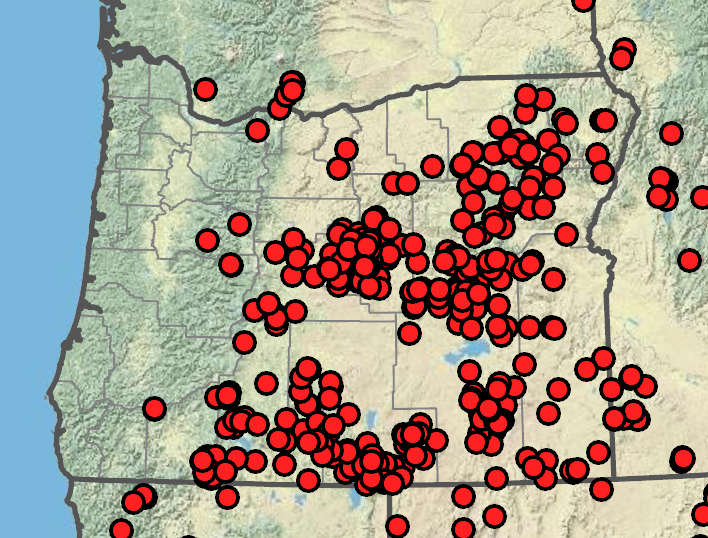|
Nebraska sedge
|
| Plants rhizomatous, but the deep rhizomes not often collected; culms 20–90 cm tall; plant bases brown or reddish brown. |
sheath fronts hyaline, not ladder-fibrillose, usually not spotted; blades (3)4–12 mm wide, usually glaucous. |
lowest bract more or less equal to the inflorescence; lateral 2–4 spikes female (or androgynous); erect; blunt or only slightly tapering at base, 3–5.5 cm × 5–8 mm; terminal 1–3 spikes male. |
elliptic to ovate to obovate, 2.6–4 × 1.6–2.5 mm, brown with reddish brown spots, strongly 5–9-veined on each face at maturity, with “sloping shoulders”; beak 0.3–0.6 mm, minutely bidentate; stigmas 2. |
lenticular. |
reddish brown to dark purplish brown; acute to awned; awn 0–0.5 mm long, sometimes scabrous. |
=66, 68. |
|
|
|
|
|
Common in riparian areas, wet meadows and other wetlands, often in alkaline sites. 100–2500 m. BR, BW, Casc, Col, ECas, Lava, Owy. CA, ID, NV, WA; north to Alberta, east to NE, southeast to AZ, MO, IL; Japan. Native. This important forage and soil-binding species is a common, rhizomatous, broad-leaved, usually glaucous, lower-elevation sedge with strong perigynium veins. Some traits traditionally used to distinguish it from relatives (leaves W-shaped vs. V-shaped in cross section or blue vs. green) do not work. Carex aquatilis, which grows in more or less acidic wetlands, has veinless perigynia with rounded shoulders. Carex angustata has ladder-fibrillose leaf sheath fronts and perigynia with one to three weak veins on each face. Carex nebrascensis populations west of the Cascades are probably recent introductions. |
Flora of Oregon, volume 1, page 216
Barbara Wilson, Richard Brainerd, Nick Otting |
C. abrupta, C. agastachys, C. amplifolia, C. angustata, C. aperta, C. aquatilis, C. arcta, C. arenaria, C. atherodes, C. athrostachya, C. atrosquama, C. aurea, C. barbarae, C. bebbii, C. bolanderi, C. brainerdii, C. brevior, C. breweri, C. buchananii, C. buxbaumii, C. californica, C. canescens, C. capillaris, C. capitata, C. chordorrhiza, C. comans, C. comosa, C. concinna, C. concinnoides, C. cordillerana, C. crawfordii, C. cusickii, C. davyi, C. deflexa, C. densa, C. diandra, C. disperma, C. distans, C. douglasii, C. duriuscula, C. echinata, C. exsiccata, C. feta, C. filifolia, C. fissuricola, C. fracta, C. geyeri, C. gynocrates, C. gynodynama, C. halliana, C. harfordii, C. hassei, C. haydeniana, C. hendersonii, C. heteroneura, C. hirsutella, C. hirta, C. hoodii, C. hystericina, C. idahoa, C. illota, C. infirminervia, C. inops, C. integra, C. interior, C. interrupta, C. jonesii, C. kelloggii, C. klamathensis, C. kobomugi, C. laeviculmis, C. lasiocarpa, C. leporina, C. leporinella, C. leptalea, C. leptopoda, C. limosa, C. livida, C. longii, C. luzulina, C. lyngbyei, C. macrocephala, C. macrochaeta, C. media, C. mendocinensis, C. mertensii, C. mesochorea, C. micropoda, C. microptera, C. multicaulis, C. nardina, C. nervina, C. neurophora, C. nigricans, C. nudata, C. obnupta, C. pachycarpa, C. pachystachya, C. pansa, C. paysonis, C. pellita, C. pelocarpa, C. pendula, C. petasata, C. phaeocephala, C. pluriflora, C. praeceptorum, C. praegracilis, C. praticola, C. preslii, C. pumila, C. raynoldsii, C. retrorsa, C. rossii, C. saxatilis, C. scabriuscula, C. scirpoidea, C. scoparia, C. scopulorum, C. serpenticola, C. serratodens, C. sheldonii, C. simulata, C. spectabilis, C. stipata, C. straminiformis, C. subbracteata, C. subfusca, C. subnigricans, C. sychnocephala, C. tahoensis, C. tiogana, C. tribuloides, C. tumulicola, C. unilateralis, C. utriculata, C. vallicola, C. vernacula, C. vesicaria, C. viridula, C. vulpinoidea, C. whitneyi, C. zikae |
|
CA,
OR,
WA
CalFlora,
CalPhotos,
Flora NW,
PNW Herbaria
WildflowerSearch
iNaturalist (observations)
USDA Plants Database

